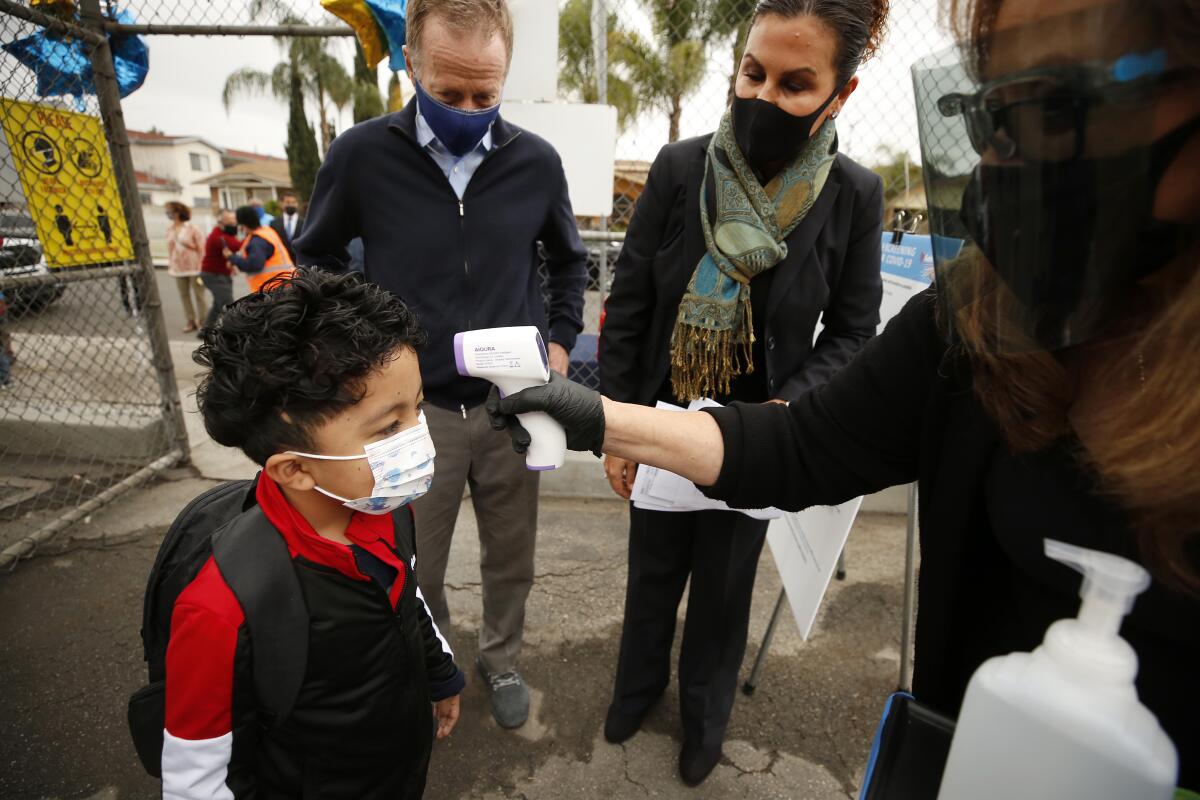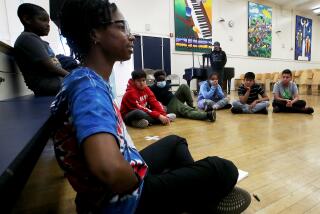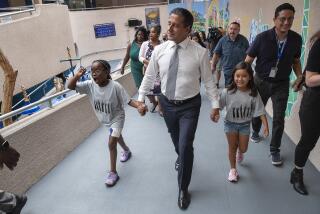Governor, LAUSD plot strategies for post-pandemic education. Think more days in class

- Share via
The Los Angeles school board considered a plan to extend the school year and approved a preschool expansion, while Gov. Gavin Newsom said he wants the state’s 11,000 campuses to fully reopen by the fall with increased services to students — all steps aimed at making up for a year of distance learning.
The tentative proposal to extend the Los Angeles school year calls for adding six additional days for students and four additional training days for teachers. For the students, at least, the plan calls for mandatory attendance. The final schedules and details are still being worked out, with a board vote expected at a later meeting.
Board member Jackie Goldberg said she approved of more instruction in general but worried about student and staff fatigue. Board member Scott Schmerelson said parents contacting him overwhelmingly opposed extending the school year.
Chief of Schools David Baca said he’s also received those same calls and emails but that the district’s formal survey presented a more nuanced and balanced view among parents across the nation’s second-largest school system.
So far, families representing about 77% of students have responded. Among those, 56% supported some kind of extension, with a fairly even split between shortening the winter recess versus starting the school year earlier. And 44% wanted no change to the calendar.
The district fully intends to offer summer school to all students. Summer school would most likely be offered in a hybrid format that combines time on campus with remote learning from home, said Chief Academic Officer Alison Yoshimoto-Towery.
There also were many other ideas discussed — such as having high school students take fewer courses at a time in a quarter system. That approach keeps students in smaller groups, potentially limiting the spread of the coronavirus.
It also appears clear that the district will need more teachers. The district is ramping up recruiting for beginning teachers and advocating for the state to lift the cap on the number of hours retired teachers can work.
Separately, the board directed Supt. Austin Beutner to return within six months with a plan to provide universal preschool for students — all the way down to age three.
“Nothing has proved the need for universal access to high-quality early childhood programs like the COVID-19 pandemic,” Board President Kelly Gonez said. “Early education puts our youngest learners on a path for success academically, socially, and emotionally, while enabling parents to engage in the workforce. Making these investments now will promote equity and have long-lasting transformative benefits for our students, families, and communities.”
L.A. Unified serves more than 22,000 students in preschool programs that serve low-income families at 87 locations. That is just a fraction of students who would be included under the proposed plan.
While the proposal envisions all children being served by the fall of 2024, Gonez’s staff estimated that the immediate expansion approved Wednesday will open 25 new classes.
At the moment, the school system can count on COVID relief dollars, but the funding commitment over time could be substantial. The cost per child for high-quality, full-day pre-K in California is estimated at $15,300, according to the National Institute for Early Education Research.
District officials hope that the Biden administration will focus on this area and spearhead federal funding efforts.
Speaking at a school in Santa Rosa on Wednesday, Gov. Newsom urged all districts in the state to invest their relief money in making up for lost educational time and said they should prepare to open their campuses five days a week, full-time for students in kindergarten through 12th grade by the fall.
“The schools have never been more resourced and ... we have the capacity to finish the job to get all of our kids safely back in in-person instruction,” Newsom said. For the coming school year, “I expect all our kids to be back. That’s what I expect, with caveats. Always with caveats: Expect our kids back safely and [in] in-person instruction in the fall.”
But he stopped short of saying he would issue a mandate or seek one in collaboration with the Legislature. He emphasized that more than 9,000 of the state’s estimated 11,000 campuses have opened or announced an opening date for the current school year.
The governor’s statements will not satisfy many parents up and down the state who’ve organized for a faster and fuller reopening during the current school year, said Megan Bacigalupi, a parent advocate with the recently formed group OpenSchoolsCA.
“Five hours per week of live in-person instruction, as my children receive in Oakland, should not be defined as an open school,” said Bacigalupi. “And sitting on Zoom in school is no one’s definition of ‘live in-person instruction,’” she added, describing the format that Los Angeles Unified intends for middle and high schools.
The state’s current rules allow remote learning to replace in-person instruction until the end of this academic year. Unless lawmakers approve new exceptions, the rules revert to their pre-pandemic form. In normal times, school districts are funded based on attendance and the amount of in-person instruction.
However, similar to last year, the governor and the Legislature could step in and set out rules permitting hybrid schedules, for example, during the budget approval process.
But the governor gave no indication of favoring such a move, instead saying school districts should extend the current school year, offer more summer school and do more in the fall, both academically and to support students’ social and emotional needs.
More to Read
Sign up for Essential California
The most important California stories and recommendations in your inbox every morning.
You may occasionally receive promotional content from the Los Angeles Times.











